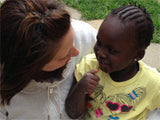The Abecedarian Approach

The Abecedarian Approach is a set of strategies used by caregivers to engage young children in individual interactions that foster cognitive and language development. Caregivers intentionally use strategies frequently throughout each day, based on each child’s current knowledge, skill level and interest. This deepens the child-caregiver relationship and provides regular opportunities for the child to hear and use language. During play and routines, children receive and respond to information about topics that are interesting and meaningful. Caregivers focus on creating strong, stable relationships with children, based on intentional, individual, and frequent interactions every day.
Watch as Dr. Joseph Sparling, one of the founders of the Abecedarian Approach, provides an overview of the Approach.
*Note: Leaning Games are now Interaction Games.
The Research:
Scientific studies have shown that the strategies can prevent the very early downward trend in cognitive development typical of many disadvantaged children. As seen in the figure below, almost all of the children in both the randomized experimental and control groups of the first Abecedarian study were in the normal cognitive range at the beginning of the study. Most of those who received the Abecedarian intervention (the upper line) continued to stay in the normal cognitive range. But more than half of those who did not receive the intervention (the declining lower line) fell out of the normal range by 36 months of age. The difference between the groups was statistically significant by the time the children were 18 months of age (Martin, Ramey, & Ramey, 1990)

The Results:
The long term positive results found in three randomized, controlled trials of the Abecedarian Approach are now known throughout the world and form a major part of the evidence that supports our current belief in the efficacy of high quality early childhood programs. Ongoing follow-up of the original research samples has demonstrated long-term:
- Educational benefits (including a 4-fold increase in university graduation) (Campbell, Pungello, Kainz et al., 2012)
- Economic benefits (including a 13% per year return on initial investment) (Garcia, Heckman, Leaf et al., 2016)
- Health benefits (including better adult blood pressure) (Campbell, Conti, Heckman et al., 2014)
More recently, a randomized study in India, Pakistan, and Zambia found that children from low-resource families who received the Abecedarian Approach delivered through bi-weekly home visits improved in cognitive development over the first 3 years of life. By 36 months of age, the children from low-resource families caught up with and equaled their higher-resource peers in cognitive development. (Bann, Wallendar, Do, et al., 2016)
Since 1972, the Abecedarian Approach has been used successfully in center-based child care, home visiting programs, family child care homes, and public-school pre-Kindergarten settings. Today, the Abecedarian Approach is recognized as an evidence-based, proven curriculum approach that forms basic principles of human learning and development into play-based, affordable, and effective strategies for early childhood education. The Abecedarian Approach clearly demonstrates that early interventions can create a lasting change in children’s lives.
National Geographic Documentary:
View this excerpt about the Abecedarian Approach from a National Geographic documentary.
The Elements of the Abecedarian Approach:
The Abecedarian Approach fits into and complements any early childhood curriculum. It consists of four elements; each with strategies to create a learning environment that supports children’s development to their fullest potential. With the Abecedarian Approach, children experience multiple individualized games, reading sessions, and information-filled caregiving and play interactions daily with responsive adults. From these intentional experiences, the adult fosters nurturing connections with the child which can create a positive lasting change in their lives.

The Abecedarian elements of Language Priority, Conversational Reading, Interaction Games, and Enriched Caregiving create a learning environment that can support children’s development to their full potential.
 |
Language Priority A commitment by caregivers to make every experience an opportunity for talking, listening, and learning language |
 |
Conversational Reading Caregivers read picture books to one or two children at a time while encouraging comments, questions, and dialogue. |
 |
Interaction Games (Previously known as LearningGames) Caregivers choose from 100 adult-guided developmental games that are played between the caregiver and one or two children. |
 |
Enriched Caregiving Caregivers add emotional connection and educational content to routines such as handwashing, mealtimes, and diaper changing. |
The Abecedarian Approach in Action:
Visit the website Community of Change: The ripple effect of an enriched early child development initiative, which documents a research study into how the Abecedarian Approach influenced the children, families, and caregivers of a child care centre in Winnipeg Manitoba, Canada.
Learn more about the Abecedarian Approach:
- Read a history of the Abecedarian Approach presented by Nova of the US Public Broadcasting System (PBS): Orstander, 2015. How Preschool Can Make You Smarter and Healthier | NOVA | PBS
- View a TED talk about the Abecedarian Approach: Gallagher, 2015.

